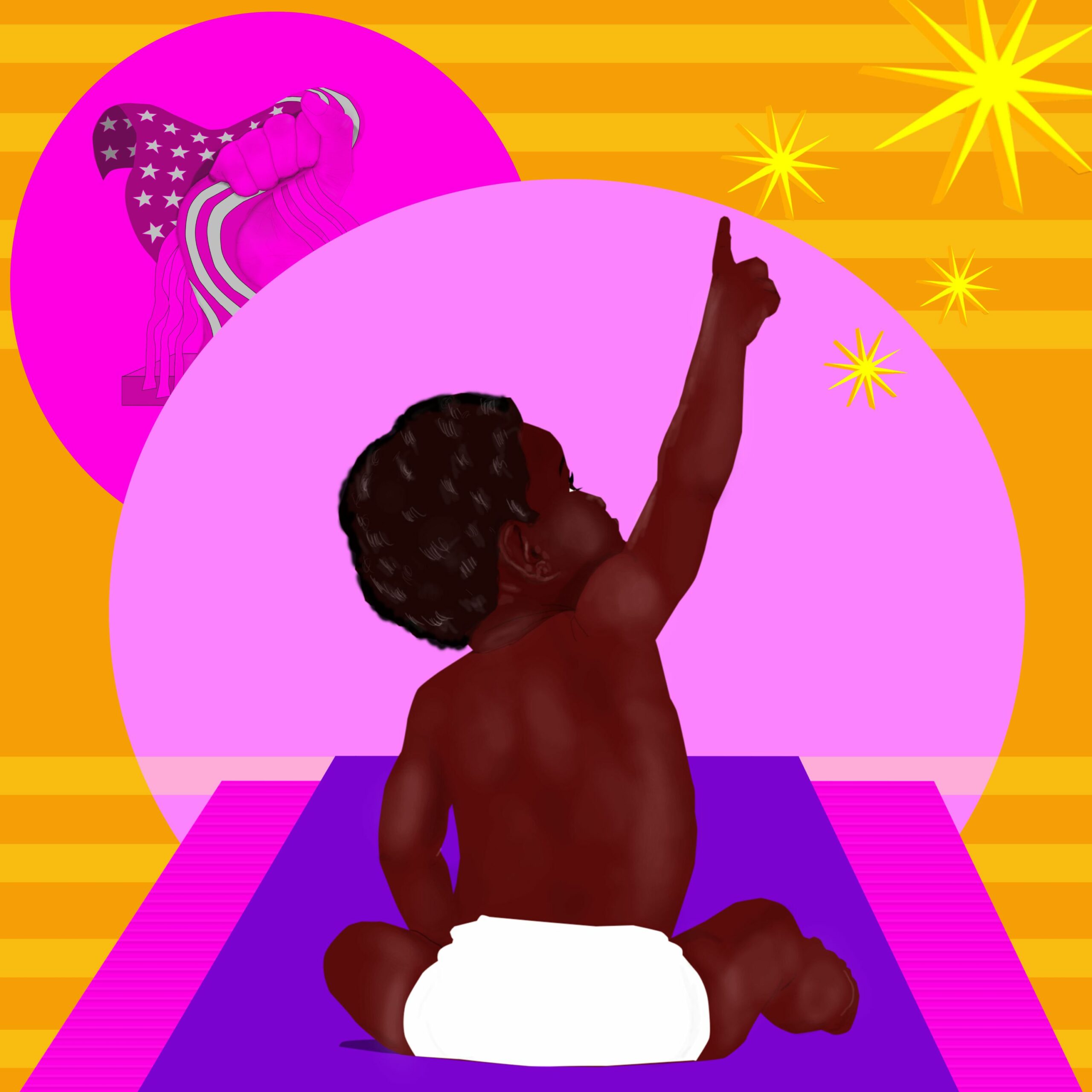
Many Black Americans at the end of the nineteenth century relied heavily on themselves, prioritizing self-determination and securing their collective destiny through solidarity, self-help, and economic independence.
But blatant racism saturated media, entertainment, and education. Parents pushed for less harmful representation of Black life for their children, resulting in the creation of lifelike dolls and print media focused on chasing away the shadows of white supremacy with the light of Black love, consciousness, and possibility.
The lessons Black children learned from their parents and surrounding adults empowered them to grasp the freedom torch and blaze new trails in the fight for liberation.
View Transcript
Kidada E. Williams: In 1914, the world of infant pageantry was turned on its head when Wesley Alexander Collins won the Newark YWCA baby contest. At just seven and a half months old, young Wesley—along with about 700 black and white babies—was evaluated on their mental and physical health, and physical appearance.
The contest was one part health consciousness, another part eugenics, with several doses of problematic domesticity. A reporter for The New York Age—a prominent Black newspaper—was on the scene:
New York Age: The physicians and nurses in the first examination declared that little Wesley was well-nigh perfect, only a coated tongue standing between him and a perfect score.
KEW: At 20 pounds and four ounces, Wesley was reported as having, quote, “proportions that are correct in every particular,” unquote. His adorable victory photo shows that he was oblivious to the fuss caused by a Black baby winning a gold medal.
But cause a fuss, it did! White families scrambled, demanding a reexamination. They even tried to hold a second, private, baby contest…
New York Age: …hoping to find some baby more perfect than Wesley Alexander Collins.
KEW: The New York Age reached out to the chief examining physician and final judge to make sure white resentment didn’t deprive Wesley of his just due. Black children were typically excluded from “better baby” contests. When they were included and were ranked highly, their achievements were often disputed.
So, the same year as little Wesley’s upset win, the paper started sponsoring its own, national contest—with 12 silver cups to be awarded to the best Negro Babies of the Country.
New York Age: Negro babies are among the best developed and most prepossessing in the world, and whenever they are entered into baby contests or baby shows in competition with the babies of other races they are usually returned as winners. The Age is now giving parents of the country at large an opportunity to show the world the future men and women of the race.
Mothers and fathers who are proud of the beauty and healthfulness of their babies will have the opportunity to let the world know on what foundation their pride is based through the Better Babies Contest.
KEW: Scores of parents sent in photos of their children for The Age’s selection committee to review. All the kids in the photos are precious and all their parents describe them as clever.
D.C. Parent: Our fine son is only 18 months old and weighs 24 ½ pounds. He is very precocious and can hold a hose and sprinkle water with as much precision as we can. It is generally acknowledged by all who know him and see him perform this feat; anything he sees another do, he tries, and in many instances surprises all by his cleverness.
KEW: Among the parents who sent a photo was Mrs. Gary, mother of 6 year-old Maud Evangeline Gary. In her photo, the brown skinned girl is wearing a smart white dress, with a white hat. Her chin-length pressed hair loosely curls around her face. But Mrs. Gary did not come to play.
She wanted to make a point about what she thought made a “better baby,” which couldn’t be judged on physical features or educational attainment alone. Better babies, she believed, were ones who had healthy attitudes about themselves and their potential—like her girl had.
And so, in the photo sent to the selection committee, Maud is holding a baby doll—almost as big as she is—with black, curly, combable hair styled with a white hair band and dressed in a fine, frilly dress.
Mrs. Gary: I do not allow her to play with white dolls, only those of her own race. I am trying to make her a race woman by daily teaching her to love whatever belongs to the Colored race.
KEW: Mrs. Gary might have gone searching for the doll in her local shop or ordered it by mail through the seller directly. In New York City, she would have had plenty of options from ads like this one from The Crisis—the NAACP’s magazine:
Black Ad-Man: The Colored Doll is a live one! Children are going wild about the beautiful Colored Dolls. For emancipation celebrations, bazaars, fairs, and the holiday trade. The dolls have becoming features, are light brown in color, have jointed limbs and eyes that open and shut. Imported by us, and endorsed by the leading clergymen and educators. EMS Novelty Co, Jamaica, NY.
KEW: Unlike ‘Christie,’ the first Black Barbie, or ‘Addy’ from the American Girl collection, Maud’s doll didn’t come with a name. But like those popular dolls, she was more than a toy or a status symbol. The doll was a symbol of Maud’s sense of self-worth.
Mrs. Gary: I think every mother should surround their children with pictures and literature of our race, that they may love one another and become united as all other races are.
KEW: To secure her daughter’s future well-being and the aims of black liberation, Mrs. Gary knew that Maud needed to be more than pretty and smart. She needed to be aware of her family’s heritage and prepared to guard her spirit to fight for her rightful place. She believed Maud’s doll would help her on that path.
Mrs. Gary: The only way to make race-loving men and women is to start in early childhood to train them for such.
KEW: This is Seizing Freedom. In this episode, coming of age during Jim Crow. Raising proud Black boys and girls in a world fueled by anti-Blackness was no small task. Blatant racism saturated media, entertainment, and education. Seizing freedom required fierce acts of parental love.
At the turn of the century, African American adults worked hard to provide Black youth with examples of their boundless potential; what some might call Black abundance and Black excellence.
The lessons Black children learned from their parents and surrounding adults empowered them to grasp the freedom torch and blaze new trails in the fight for liberation.
Maud Evangeline Gary’s mother was one of many Black parents whose love for their children and hope for their futures often coincided with the fear of what both white supremacy and individual white people would do to them.
Starting in the 1830s, blackface minstrel shows took the entertainment world by storm. They lasted for more than a century and produced a menagerie of racist images and songs distorting Black people’s physical features, portraying them as lacking style or refinement, and being childish, lazy, ignorant and servile.
Yes Sir Mr. Bones (song): I want you to know that I’m ragged but right / Hopin’ like I’m livin’ like you people that’s white.
Cotton and Chick Watts (skit): White woman: How would you like to go to work for me?
Man in blackface: Yes ma’am. How much you gonna pay me I hope?
Woman: Well, let’s see now. I’ll pay you all you’re worth.
Man: No, ma’am I gotta have some money!
Jump Jim Crow (song): Wheel about and turn about and do just so / every time I wheel about I jump Jim Crow.
KEW: In the late 19th century, minstrelsy shifted from a performance to the mass production of material goods where racist representations took on a life—and economy—of their own. Mammy and Sambo trinkets, coloring books and postcards, ads for food and household products flooded the marketplace. They were even common in instructional tools to introduce children like Maud Gary to the world, like the book, ABC in Dixie.
ABC in Dixie: D is fer Dan’l who ‘tens ‘ter de do’ He tuk kyar er Massa, ‘way bac’ fo’ de wah.
KEW: And this included dolls. For many, dolls seem like harmless playthings, connoting childhood innocence and vulnerability. However, from identity and cultivating domesticity to shaping choice of future life partners and destinies, dolls are fully encoded with racial and gender politics.
In the late 19th and early 20th century, white commercial doll makers—like the Jumeau company—were using dolls to extol white children as sympathetic, vulnerable, innocent angels with the whitest skin and the reddest cheeks, and to denigrate Black ones as unfeeling and troublesome: the out of control, thoughtless, wicked “pickaninny” with exaggerated features of impossibly wooly hair, excessively wide mouths, and skin as “dark as tar.”
This wasn’t just implicitly understood; ads like this one from Happy Family Advertisements, published in 1893, didn’t mince words:
White Ad-Man: What white child in America does not at some time want to clothe a [N-word] dollie—one that can be petted or thrown about without harm to the doll or anything that it comes in contact with. “Pickaninny” fits all the requirements most completely.
KEW: Before 1900, Black parents didn’t have many alternatives. They could keep hand-making individual dolls for their children—as their mothers and grandmothers had done for centuries—Or they could purchase manufactured dolls and racist caricatures.
This infuriated Black parents like Chicagoan Mrs. Alvah Bottoms. She wrote Half-Century Magazine about objectionable dolls she encountered while Christmas shopping and the horrible lessons they taught children.
Mrs. Alvah L. Bottoms: I saw a young white woman leading a 3 year old child by the hand to the toy department, where a number of other mothers were lined up to take their children in to see Santa Claus.
When the white child reached the tiny house in which Santa was seated, she named a number of things she would like to have for Christmas and finally added, “Oh, yes, Santa Claus, please don’t forget to bring me a dancing [N-word] and an Aunt Jemima doll, like that one over there.” She pointed to a doll that looked like a lanky old colored man dressed slovenly in ill fitting clothes that bore a label that said “Alabama dancing coon.”
KEW: Several other Black mothers in line with Mrs. Bottoms turned, saw the dolls, and ushered their kids out of the store. According to researchers, and even Black adults looking back on their lives, these representations could steal kids’ childhood, and distort their sense of self, which stalked them throughout their lives and undermined the collective fight for a liberated future. The dolls also gave white children permission to be racist.
Mrs. Alvah L. Bottoms: No doubt that small white child will soon receive that “dancing coon” and the “Aunt Jemima” doll on Christmas morning and she’ll form a number of conclusions. She’ll learn to call all Colored people [N-word] or “coon” and she’ll gain the idea as she gets older that all Colored men are fit for is to dance and amuse white people; Her Aunt Jemima doll will give her the impression that Colored women are fit only for servants.
KEW: One of the challenges Black parents had was that they were shopping in a sea of white products, art, and images. Mrs. M. Mack from Chicago also wrote Half-Century Magazine insisting on Black representation, especially in Black homes and publications.
Mrs. M. Mack: There are just as many pretty Colored girls as white; there are just as many beautiful Colored mothers and babies as white; there are plenty of fine Colored farms, dairy maids, farmerettes—and I don’t see any reason why a pretty brown skinned mermaid couldn’t sun her curly black locks on a rock in a sea and made a more beautiful picture than a white one could.
KEW: Finding there to be “too many white pictures” in places she shopped for home decor, Mrs. Mack called on Black consumers to demand art shops carry more art with Black people in it. Like Mrs. Gary and Mrs. Bottoms, Mrs. Mack sought representation in dolls, too.
Mrs. M. Mack: I have purchased pretty Colored Dolls for my children so that they will learn to love and respect heroes and beauties of their own color.
KEW: The children of Black Reconstruction freedom fighters who had moved to cities—the people of Mrs. Mack and Mrs. Gary’s generation—responded to the call.
In 1907, a Baptist businessman and newspaper owner named Richard Henry Boyd helped establish the National Negro Doll Company. The following year, dolls were a huge topic of conversation at the annual conference of Black Baptists in Lexington, Kentucky. Ministers left the conference and immediately petitioned their congregants to buy Black dolls for their children.
New York Age: The resolution passed there petitioning all Negro Baptists to henceforth buy Negro dolls for their children, in our opinion, is a timely and mighty step in the right direction.
The Negro child playing with white dolls, to the detriment of his own race pride and race confidence, is imbued with foreign standards of beauty and culture. This sensible change in equal sentiment for toys and ornaments will profoundly affect Negro nature.
KEW: The earliest manufactured dolls were imported from Europe and sold in emancipation celebrations, fairs, and Christmas church bazaars. Magazines like The Crisis included ads for these dolls for their Black readers.
With the church’s blessing, Black doll usage spread quickly. During the 1908 holiday season, the National Negro Doll Company reportedly sold about 3,000 dolls to places as far from Nashville as Spokane, Washington. The Christian Recorder, the publishing arm of the AME Church, told its subscribers:
Christian Recorder: No toy you can buy for a small Colored girl will instill more of self-respect in her—unconsciously— than a Colored doll. Burn up the others.
KEW: In 1912, The National Negro Doll Company stopped shipping dolls from Germany and opened their own factory in Nashville to meet high demand, producing more Black dolls that actually looked like the kids who would play with them—without the stereotypes.
Throughout the 1910s, manufacturers like Berry and Ross, the Gadsden Doll Company, and the EMS Novelty Company sprung up to compete in the marketplace. In July 1919, The Crisis ran a profile of the Success of the National Colored Doll and Toy Company and the woman responsible for it: Theresa Cassell.
The Crisis: Miss Cassell says she wanted to redirect the ideas of Colored children; She wanted to inculcate them in the beauty and the message to be derived from a doll with a “Colored” face. She believed innately that Colored children should be taught to cherish the ideals as pictured in a Colored doll; In the beauty of a brown skin; And the wave of curly hair; In the charm of perfect white teeth; In the contagiousness of a smile.
KEW: The Colored Doll & Toy Company offered an array of dolls, from infants to toddler sized ones—like Maud Evangeline Gary’s. Advances in technology, like the use of unglazed porcelain and a range of brown tints, allowed the dolls to be more lifelike than handmade ones. They could be put into sitting positions, and stand upright. These physical features, however, made them more expensive; Mrs. Gary likely paid a lot to buy Maud the doll she believed she deserved.
Although dolls could be expensive, the National Negro Doll Company set them ranging from $0.50 to $8.50, which made them more accessible for working-class families—the majority of the country—many of whom were one injury, illness, death, or late paycheck away from poverty. There was a lot riding on these dolls’ shoulders.
The success of these toy companies supported Black parents’ quest to raise “race-loving men and women.” But toys didn’t have to carry the weight of Black children’s future alone. New developments in print media—the same media that heavily advertised Black dolls—also supported parents and kids on their journeys.
KEW: Black parents knew that they had to guide their children through the tumultuous waters of their emerging double-consciousness: those primal moments when Black youth come to understand the profound contradictions of the nation’s stated principles and their realities as Black people in America.
As W.E.B. Du Bois put it, in his book The Souls of Black Folk:
W.E.B. Du Bois: The Negro is a sort of seventh son, born with a veil, and gifted with second sight in this American world, a world which yields him no true consciousness, but only lets him see himself through the revelation of the other world. It is a peculiar sensation, this double consciousness, this sense of always looking at one’s self through the eyes of others, of measuring one’s soul by the tape of a world that looks on in amused contempt and pity.
KEW: These moments of double consciousness could come through the erasure of black people’s existence in history books or that existence being exposed in only the most dehumanizing light.
As Reconstruction gave way to Jim Crow, moments of double consciousness could come when children rode segregated streetcars with their families and watched as their parents were forcibly removed from their seats. They could come when their white classmates—some as young as 12—were pictured in the paper, celebrating a lynching.
WEBDB: One ever feels his two-ness; an American, a Negro; two souls, two thoughts, two unreconciled strivings; two warring ideals in one dark body, whose dogged strength alone keeps it from being torn asunder.
KEW: Du Bois described moments like these as “shadows” sweeping across the light of young Black hearts and minds, dimming their pride in their ancestors’ heritage, and their outlook for the future.
WEBDB: It is in the early days of rollicking boyhood that the revelation first bursts upon one, all in a day, as it were. I remember well when the shadow swept across me. I was a little thing, away up in the hills of New England…
KEW: He remembered exchanging early 20th century versions of “calling” cards with other boys and girls so they could meet up and hang out later.
WEBDB: The exchange was merry, ‘til one white girl, a tall newcomer, refused my card—refused it peremptorily, with a glance. Then it dawned upon me with a certain suddenness that I was different from the others…in heart and life and longing, but shut out from their world by a vast veil.
KEW: Du Bois didn’t want to live behind that veil; he didn’t want to be white. But even at that age, he knew his white peers would automatically receive “dazzling opportunities” in the years ahead—luxuries of life denied to boys like him—solely on the basis of race. Fueled by contempt and anger, Du Bois pledged that he would grab as many opportunities as he could, for himself.
WEBDB: Just how I would do it I could never decide: by reading law, by healing the sick, by telling the wonderful tales that swam in my head…some way.
KEW: He knew he had an awareness and privileges not all boys—or people—enjoyed.
WEBDB: With other black boys the strife was not so fiercely sunny: their youth shrunk into tasteless sycophancy, or into silent hatred of the pale world about them and mocking distrust of everything white; or wasted itself in a bitter cry: Why did God make me an outcast and a stranger in mine own house?
KEW: In order to combat the effects of double-consciousness, many Black Americans at the end of the nineteenth century relied heavily on themselves, prioritizing self-determination and securing their collective destiny through solidarity, self-help, and economic independence.
Around this same time, there was an emergence of a larger Black print culture that protested injustice and celebrated Black achievement. Before Jet and Ebony magazines arrived in the 1940s and 50s, there was The Colored American, the Voice of the Negro, and The Crisis: illustrated literary monthly magazines that chronicled Black life and achievements.
The Crisis was (and is!) the official magazine of the NAACP. First published in 1910, it’s still running as a quarterly journal. W.E.B. Du Bois—who helped found the magazine and edited it for two decades—wanted it to be:
WEBDB: …a record of the darker races meant to set forth those facts and arguments which show the danger of race prejudice, particularly as manifested today toward Colored people.
KEW: Once a year, in its early days of publication, The Crisis released an issue devoted entirely to youth.
WEBDB: We are and must be interested in our children above all else, if we love our race and humanity.
KEW: “The Children’s Number” was the most popular issue of the year. It included stories and fairy tales, photos of cute naked babies, articles, news bulletins, and letters from readers.
With all the realities of the day—lynching as a near weekly occurrence, increased segregation—and the goal of educating its readers (young and old), The Crisis found it necessary to include some heartbreak or horror in each children’s issue.
The first page of the October 1919 Children’s Issue includes gruesome press reports:
Crisis 1: Eli Cooper, a Negro, was shot to death in a church at Ocmulgee, Georgia, by a mob. The church was then burned…
Crisis 2: A mob stormed the jail at Knoxville, Tennessee in search of Maurice F. Mays, a Negro…
Crisis 3: Lucius McCarty, a Negro accused of an attack on a white woman, was lynched at Bogalusa, Louisiana, his body dragged through the streets and then burned…
KEW: In the rest of the issue, interspersed between photos of smiling siblings, ads for dolls, and books on the glory of Black Reconstruction, are detailed reports on the Red Summer of 1919 when white people rampaged in cities across the country, massacring Black people. The reporting also detailed how many Black people fought back.
Du Bois wondered about the psychological effect this would have on Black children.
WEBDB: To educate them in human hatred is more disastrous to them than to the hated; to seek to raise them in ignorance of their racial identity and peculiar situation is inadvisable—impossible.
KEW: Black kids needed a better balance. And so, in 1920, The Crisis expanded its offerings by releasing The Brownies’ Book, a monthly children’s magazine. The dedication read:
Jessie Redmon Fauset: To Children, who with eager look / Scanned vainly library shelf and nook / For History or Song or Story / That told of Colored People’s glory – / We dedicate The Brownies’ Book.
KEW: Du Bois and fellow editor Jessie Fauset said the magazine was created for all children, “but especially for ours, the ’Children of the Sun.’” The Brownies’ Book was meant to be read in collaboration with attentive parents—the kind of mothers and fathers who might have insisted that their children had Black dolls. In the magazine’s launch, Du Bois announced:
WEBDB: It will be a thing of joy and beauty, dealing in happiness, laughter and emulation, and designed especially for kiddies from 6 to 16…It will seek to teach universal love and brotherhood for all little folk—Black and brown and yellow and white…Of course, pictures, puzzles, stories, letters from little ones, clubs, games and, oh, everything!”
KEW: While it’s unclear how many total subscribers the magazine had, they produced 24 issues over the course of their run, from 1920-1921, that subscribing Black families—who knew about it and could afford it—adored. One parent eager to read The Brownies’ Book to and with their children was Bella Seymour.
Bella Seymour: My little girl has been studying about Betsy Ross and George Washington and the others, and she says, “Mama, didn’t colored folks do anything?” When I tell her as much as I know about our folks, she says, “Well, that’s just stories. Didn’t they ever do anything in a book?”
KEW: Just as children and their parents were assaulted on a daily basis with racist representations of Blackness when they sought toys and games, they encountered erasure and distortion in classrooms, libraries, or whenever they sought to learn U.S. and global history.
Bella Seymour: I have not had much schooling, and I’m a busy woman with my sewing and housekeeping, so I don’t get much time to read and I can’t tell my little girl where to find these things. But I’m sure you know and that now you will tell her. Our little girl is dark brown, and we want her to be proud of her color and to know it isn’t the kind of skin people have that makes them great.
KEW: Brownies readers like Claudia Moore, a student in Pittsburgh, wrote in to the magazine to say that she was tired of the mainstream commemorations that excluded her people.
Claudia Moore: I get so tired of hearing only of white heroes and celebrating holidays in their honor. I think every year we ought to have parades or some sort of big time on Douglass’ birthday and on the anniversary of Crispus Attucks’s death.
KEW: Alice Martin, a student in Philadelphia, wrote about how alienated she felt in school:
Alice Martin: Sometimes in school I feel so badly. In the geography lesson, when we read about the different people who live in the world, all the pictures are pretty, nice looking men and women, except for the Africans. They always look so ugly. I don’t mean to make fun of them, for I am not pretty myself; but I know not all Colored people look like me. Last week the girl across the aisle for me in school looked at the picture and laughed and whispered something about it to her friend. And they both looked at me. It made me so angry.
KEW: Pocohontas Foster of Orange, New Jersey, wrote to say how tired she was of her history education:
Pocohontas Foster: I have never liked history because I always felt that it wasn’t much good. Just a lot of dates and things that some men did, men whom I didn’t know and nobody else whom I knew, knew anything about. Just something to take up one hour of the three hours left after school.
KEW: But she found new inspiration in The Brownies’ Book:
Pocohontas Foster: But since I read the stories of real Colored people, whom I feel that I do know because they were brown people like me, I believe I do like history, and I think it is something more than dates. I read these stories to a little friend of mine, Beatrice Turner, who is only eight years old, and she said, “Now that’s the kind of history I like.”
KEW: Du Bois would later say he wanted children to see that they could be “great, heroic, or beautiful.” Examples written by a cadre of Black and white contributing writers were abundant in the magazine’s illustrated histories of Black achievement. One of the editors, likely Jessie Fauset, said:
Jessie Redmon Fauset: And when the stories are of real people who have passed through real suffering and have achieved real Triumph, my admiration goes beyond all bounds. Everything that has been done once, may be done again, and someday some man realizing what one before his time has accomplished, will do all that and more. Sometimes defeat can be more splendid than a victory.
KEW: The diversity of Black excellence from across the African diaspora was groundbreaking. Articles featured histories of Crispus Attucks, Denmark Vesey, Sojourner Truth, Harriet Tubman, and Toussaint L’Ouverture.
The magazine also made space for lesser known freedom fighters, like Katy Ferguson, a woman born into slavery in 1774, and who received extensive religious instruction from her mother. Katy purchased her freedom with the help of abolitionists and then established one of the first Sunday schools in the U.S.
Jessie Redmon Fauset: So now you know the story of a noble Colored woman. But she is not the only Colored woman to do great deeds for her race. There are many splendid Colored men, too. Think of all the wonderful folks you have still to hear about!
Pocohontas Foster: I just love to think about that nice old lady and all she accomplished, although she began with nothing. When I think of how much more happily Colored girls start out in life now it seems we ought to be able to accomplish almost anything.
KEW: Parents and The Brownies’ Book’s editors hoped to chase away the shadows of white supremacy with the light of Black love, consciousness, and possibility. They knew Jim Crow forced Black youth and adults to navigate torturous mental maps of who they were and where they could be in the wider, white-dominated world, and they wanted to chart an uplifting path back to the love of their people. The magazine’s columns, stories, games, and artwork were overflowing with affirmations. Take, Madeleine G. Allison’s “Children of the Sun”:
Madeleine G. Allison: Dear little girl of tender years, / Born of a race with haunting fears– / Cried not north cipher wrongs done to you, / Your cloud has silv’ry lining, too.
Dear little son, be not in gloom, / For fears this world has no more room; / God in his Wisdom gave you hue / Of which He’s proud, yes, proud of you!
KEW: The magazine also included a “Little People of the Month” section celebrating Black youth’s accomplishments in their schoolwork and their talents. Right there, in the same magazine that they might learn about Katy Ferguson, they’d also learn about local children like Lillian Jones. And Lillian would get to see herself in print.
Jessie Redmon Fauset: Dancing is fun for us, but Lillian Jones has made her dancing bring greater pleasure, for at the annual circus of the West Philadelphia High School, from which Lillian graduated in June, she interpreted Nevin’s ‘Narcissus’ and was awarded a prize. This marks her second annual award.
KEW: Most of the children featured in the magazine appeared to be well-to-do, of course, with their parents likely participating in racial uplift campaigns and enjoying the financial means to afford NAACP membership dues, subscriptions to The Crisis and The Brownies’ Book, and resources to raise children in relative comfortable privilege.
While the magazine included many stories of success, it also included stories that reflected the lived experiences of other Black children, who likely did not have the same financial freedom as most of the young Black readers of The Brownies’ Book. The story of Roderic illustrates the reality of struggle and the unwavering spirit that some youth demonstrated to transcend it, for their families, and themselves.
Jessie Redmon Fauset: Roderic is only eleven years old; yet he has been selling newspapers for four years! Every week he sells 50 copies of the New York News, 50 copies of Amsterdam News and 25 or 30 copies of the Chicago Defender. Sometimes he sells monthly magazines and in the summer he peddles refreshments. He lived with his grandmother for a while and then he helped her with his earnings. Now he lives with his mother again, and this year he has bought his shoes and suit for school—which of course he goes to school—he is in grade 6.
During the month of September, this past year, he was one of 9 boys whose names appeared on the Honor Roll. Every Thursday morning he is an early bird, reporting to the office of the New York News at 5 o’clock, where he puts inserts in the papers until 8. Then he goes home, gets his breakfast, cleans up, and gets to school on time. Don’t you think that the pony and New York City, where Roderic lives, and all of us, ought to be proud of him?
KEW: The Brownies’ Book editors saw “little people” as their junior partners in the fight for liberation. Recognizing young people’s voice and right to be heard, they embraced call-and-response exchanges, inviting readers to write in—which they did—sharing bits of information about themselves, their experiences in life, their visions of who they were in relation to their people, and their reactions to the stories in the magazine.
The letters, ostensibly from real readers, were published in a section titled “The Jury”, as in, the Brownies rendering verdicts on the magazine’s stories. Many shared their appreciation for general coverage, like Edith Lewis did.
Edith M Lewis: I received The Brownies’ Book. I think it is very nice. I think you can learn a lot in those little paragraphs, [and in] “As the Crow Flies.” I like the Easter number best of all. There is one paragraph I was interested in about Mr. Matthew Henson. I know about Mr Henson—his wife sings in our choir at Abyssinia Baptist Church, and I would love to read about people I know. I’m anxiously awaiting the next number.
KEW: Annie Elizabeth McAden’s letter reflected the editors’ visions for the magazine back to them.
Annie Elizabeth McAden: Please allow me space in your paper to tell you how I enjoy reading The Brownies’ Book. I have received 3 copies and they are the most interesting books that I have ever read, and I love them because they tell about my own race.
Mrs. Gary: I think every mother should surround their children with pictures and literature of our race, that they may love one another and become united as all other races are.
KEW: By the time The Brownies’ Book was published, Maud Evangeline Gary, would have been eleven—old enough to read on her own, or with her mother. We don’t know if their family subscribed.
But letters by children published in the magazine seem to have met the editors’ visions for its impact—and Mrs. Gary’s desire to make unapologetically Black men and women out of that generation of children—by training them to see themselves as Du Bois and others saw them: as “great, heroic, and beautiful.”
Mrs. Gary and W.E.B. Du Bois would count the explosion of representation in Black dolls and The Brownies’ Book as two wins in a larger fight for the next generation. That work empowered children to grow up to fight in the Freedom Struggle, just as the race-loving men and women intended.
Voice Actors

Aaron Goodson
Voice of The New York Age, Christian Recorder

Andrew Hairlson
Voice of Black Ad-man

Candice Holley
Voice of Mrs. Alvah L. Bottoms, Bella Seymour, Crisis 3

Chiquita Melvin
Voice of D.C. Parent, Mrs. M. Mack, Crisis 1

Constance Swain
Voice of Mrs. Gary

Dustin Ebaugh
Voice of White Ad-man

Jasmine Bracey
Voice of The Crisis, Jessie Redmon Fauset, Madeleine G. Allison, Crisis 2

Maya Reed
Voice of Edith M. Lewis

Micah Mundt
Voice of Claudia Moore, Annie Elizabeth McAden

Samari Jones
Voice of Alice Martin

Shiloh Jones
Voice of Pocohontas Foster

William Barnett
Voice of W.E.B. Du Bois
Episode Resources
The following resources were utilized in the research and creation of this episode:
- American Public Radioworks – “Remembering Jim Crow”
- Paula Austin – Coming of Age in Jim Crow DC: Navigating the Politics of Everyday Life
- Robin Bernstein – Racial Innocence: Performing American Childhood from Slavery to Civil Rights
- Hazel V. Carby – Race Men
- William Chafe, et al eds. – Remembering Jim Crow: African Americans Tell About Life in the Segregated South
- Marcia Chatelain – South Side Girls: Growing Up in the Great Migration
- Michelle Coles – Black Was the Ink
- Duke University – Behind the Veil: Documenting African-American Life in the Jim Crow South
- Diane Johnson-Feelings, ed. – The Best of the Brownies’ Book
- Jennifer Khawam – Teaching About United States Reconstruction with Black Was The Ink
- Library of Congress – The Brownies’ Book
- Kiese Laymon – Heavy
- Kiese Laymon – Long Division
- Michele Mitchell – Righteous Propagation: African Americans and the Politics of Racial Destiny after Reconstruction
- Jennifer Ritterhouse – Growing up Jim Crow: How Black and White Southern Children Learned Race
- LaKisha Simmons – Crescent City Girls: The Lives of Young Black Women in Segregated New Orleans
- The Tennessee Historical Society
